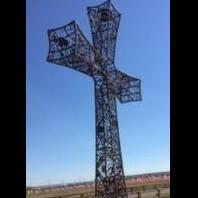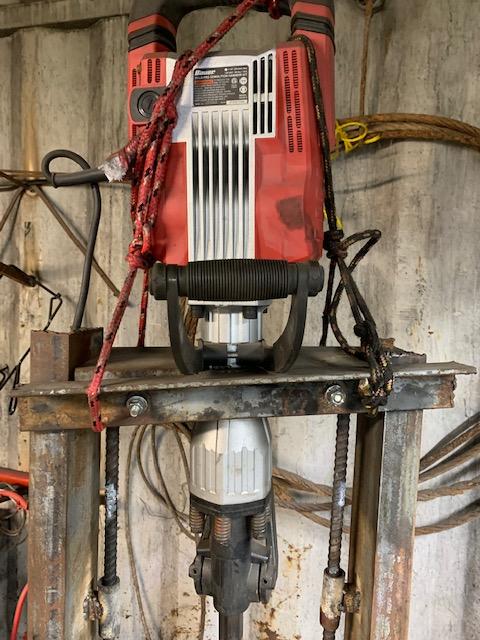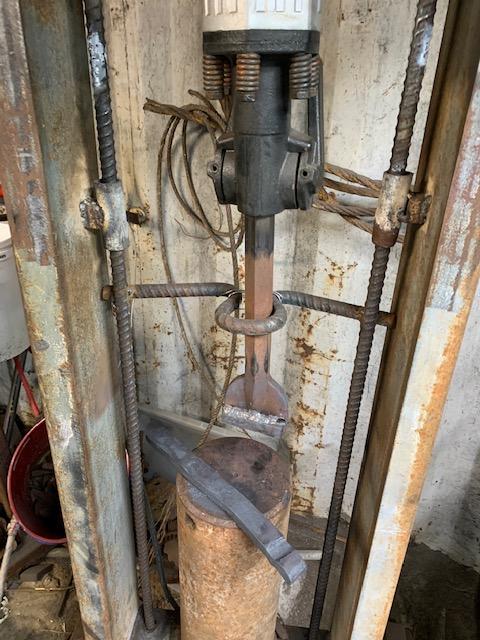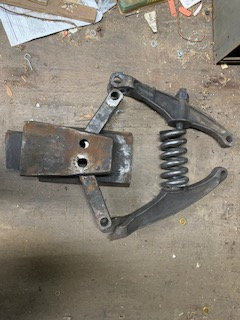-
Posts
421 -
Joined
-
Last visited
Content Type
Profiles
Forums
Articles
Gallery
Downloads
Events
Everything posted by Purple Bullet
-

Damascus welding in induction forge
Purple Bullet replied to jason0012's topic in Induction Heating, Oil forges, etc
I know the question was asked by jason0012 back in 2017 and has generated some good comment, but no direct answers I could see. I recently got one of the chinese 15 kw units. I was using a home made gas forge along with my coal forge, but the coating kept getting damaged and I found myself wearing a full-face respirator until I got around to repairing the coating. Then I thought "Why have a forge that I need all this equipment to be around?" I'd seen an induction forge in action and decided to get one after a little research. I got a plastic cart and use the bottom section as a water reservoir. I bought a sprayer pump and made some loose copper coils with a small fan blowing across for cooling. It rarely if ever freezes down here so I just use a handful of copper sulfate crystals to control algae. I've only made one coil for it so far (I cut the fittings from the original coil and brazed a 1/4" adapter on.) I have been able to make up billets from scratch using saw blades and banding material, however, I'm having cracking issues that are probably material related. I think some of the saw blades may be a little red short. Heating starts in the welds, but the layers do get to welding heat. Where I have a real problem is in making cable damascus. The steel fibers are too small to be properly affected by the coil. I fire up my coal forge to do the initial consolidation of fibers, then move to induction for shaping. My next trial will be cannister. My pastor is an avid fisherman and I want to make a fish hook damascus blade for him. From some of the discussion above I hope that the heat generated in the casing will be transferred through the cannister. That is what has to happen anyway when using any other forge, right? I'm thinking about making a "taco" coil as illustrated by EJ of the Anvil and using rectangular tubing (~2" X .75") for the cannister. I happen to have some and figure something close to the blade dimensions will distort less as I hammer it to shape so the fish hooks will still be recognizable. I'll post the results when I get around to trying it. -

Filling DIY RR Track Anvil with Sand?
Purple Bullet replied to IrregularReno's topic in Repairing and Modification to Anvils
Nice work. Sand shouldn't hurt the rebound any. If you want rebound you may need to harden the face. The rails can be heat treated but I don't know what the weld filler is. Way long ago I used some hard surface rods to repair the face of an anvil that I still use but the last time I priced hard surface rods I went into sticker shock. Another possibility for a softer section is something called "Cherry Red". If you go that route, be sure to read and follow the directions. It can make a thin layer hardenable. Of course the other thing you might do with the soft section is leave it soft. Its good to have a soft area for chiseling into. I doubt that right down the middle of the anvil is where you'd want it, though. Still, I wouldn't obsess over it. The nice thing about anvils made of junk is that you don't mind grinding on them to dress them as needed. -
I went to an estate sale to look at a milling machine /drill press. They had a 50# Little Giant but one arm was broken, the other had been broken and welded. Both lower arms (toggles?) were homemade replacements. The price tag said $1200. I told them all I could offer was $800. They said "sold!" It literally followed me home, but it took three hours of greasy sweat to persuade it into my trailer. Trailer was only rated for 2200# so I had to leave the milling press. It's bearings were shot anyway. I replaced all the home made parts with parts from Little Giant and now it is happily thumping away. BTW, since that picture I have replaced the romex with flex conduit. I only had that for testing.
-

Sources for 1060 Square bar?
Purple Bullet replied to Greebe's topic in Blacksmithing, General Discussion
The curved spring "anchors" that are sometimes placed on either side of a railroad tie are reputed to be somewhere close to 1060. I'm not suggesting you go get any off a track as railroads trend to frown on that, but if you can find any strays off the right of way they will suit your purpose. I've made a few knives and tomahawks from them and oil quenched and baked at 425 deg F for a little over an hour produces something that holds an edge fairly well. Just keep in mind I'm not a professional. I've given away every knife or tomahawk made that way and I haven't had any complaints. This advice is free as well and I assure you it is worth every penny of it. -
Thanks for the clarifications. On the one hand, that makes me not so hot to trot on getting into pattern welding, on the other hand I always liked the rain drop pattern if I do try it I'll do it without the false impression I'm making something for function rather than for show. Otherwise I may just stick to cable. It's fun, makes a good knife and with the coming demise of the oil industry around here there will be lots of material to work with.
-
So is the purpose of pattern welding, or Damascus just for the "look"? I've made a couple of cable-damascus knives and they turned out OK. Hold an edge pretty well, but I'm thinking about trying some multi-steel billets now that I have a power hammer working. I always thought (just an assumption, I don't have any documentation) that the whole point of Damascus was to combine the hardness with toughness and that it was desirable for both metals to intersect the edge. Twist, feather or ladder would lend itself to that, raindrop would not. The reason, and again, I'm supposing, is that the great "secret" of Damascus knives was they never (or rarely) needed sharpening due to the fact that as the edges wore, the softer metal wore first and left sharp points of the harder metal, making in effect serrations. Is this right?
-

Power hammer partial noise enclosure
Purple Bullet replied to Adodero's topic in Power Hammers, Treadle Hammers, Olivers
You might get some reduction of noise that way, and it sounds like your shop is conventional construction. Mine is made from cargo boxes with a lot of the walls cut out. These are anchored to a heavy slab so whenever I operate either hammer it's like a bass drum when I run the 50# Little Giant or a giant snare drum when I run my jackhammer hammer. This requires social, rather than aural engineering. Make friends, do favors, show them what you're working on and don't use the hammer (any hammer) between 8 pm and 8 am. Friends that know what's going on are very forgiving. Strangers who hear mysterious thumpings are not. -

Jackhammer for forging?
Purple Bullet replied to Austin Ferraiuolo's topic in Power Hammers, Treadle Hammers, Olivers
Forgot to mention, that was the first time I've fired this up since getting my 50# Little Giant running. I still have a lot to learn about that LG, though. The jackhammer hammer has been just a one-trick-pony, saving my aging arm when straightening and drawing out those tough clips. I've made a few Bowies and Kukris out of them. -

Jackhammer for forging?
Purple Bullet replied to Austin Ferraiuolo's topic in Power Hammers, Treadle Hammers, Olivers
None - It's not the anvil that raises. Sorry its not any clearer, but the pedal forces up the rebar push-rods (they are on rollers) and that pushes up the jackhammer which is LOOSELY held in a cross piece, but tied in with rope to keep it upright. I'm going to try to upload a short video of hammering out the little curlicues on the end of those spring clips you find near a rail road Jackhammer.mp4 -
I don't know where you are getting your railroad spikes, but your same source may have the arched clips that are hammered to the underside of rails to keep cross ties aligned. I read on another forum where these are close to 1060. I've made tomahawks and a few knives out of them, quenched in oil and tempered to 220 deg F for an hour. They seem to hold an edge good enough for utility use. I know if I had gift cards to a steel supplier I would save them for a special project after gaining more experience and I would make tools out of coil springs, as Frosty alluded, or those rail clips. Oh yeah, and don't be afraid to try tongs, especially out of railroad spikes or mild steel. I've made a few really ugly tongs, but still find them useful. Make your mistakes learning on junk and save the good stuff for when you have confidence in your skill.
-

Jackhammer for forging?
Purple Bullet replied to Austin Ferraiuolo's topic in Power Hammers, Treadle Hammers, Olivers
I realize this thread is old, but heck, so am I. After I retired from my greatly varied career I re-started an old hobby I had of smithing. I found out quickly that I couldn't swing a hammer as long and strong as I once did, so for brain-damage type of straitening and drawing, I put this together. Thomas and Frosty are correct that it is not optimal and requires a wide "top die" welded to it AND a quick hand to move the steel around before it gets a deep channel bashed in it but it is good for straightening the (reputed) 1060 spring steel you can find laying around near railroad tracks. The anvil is the pin of a 100 ton shackle I found at the bottom of the Mississippi River back when I was a commercial diver. Hard to see in the pic, but I welded casters to the bottom of the push rods that ride on the angle iron pedal. I use a foot switch to activate. I recently accidently bought a "basket case" 50# Little Giant. Still have a bit of work to get it going but i don't know how much I'll use Ole Jack once I do. -
Thanks for the posting. I just accidently bought an abused LG 50# at an estate sale for $800. One toggle arm was broke and the other had been welded. I can afford the replacement parts from LG, but I figure fabricated would be stronger than cast. I have a plasma table and I'm thinking of cutting two pieces from 1/2" plate, welding together and spreading one end for the yoke end and welding on a holder for the spring. I will probably drill the holes for the pins and may harden the inside of the holes with Cherry Red. On the other hand, store bought would enhance resale value. Your post has me leaning to fabricating.
-

Kentucky Cumberland Coal CO
Purple Bullet replied to Wylde32's topic in Solid Fuels: Coal, Coke, Charcoal, Wood, etc
Grace Fuels in Asheville , NC sells bulk. I'm just getting started (or I should say re-started) forging. I had a little coal I'd purchased from a hardware store in Carencro, La. about 40 years ago. I never was able to weld with it. It made huge clinker quickly. I got this batch from Grace fuels and made my first forge weld ever on my third try with it. It is metallurgical grade bituminous that comes from Kentucky. I'm not real experienced, but this seems to be good stuff. -
Eric mentioned above that over 12" diameter you get diminishing returns. I understand this to mean not diminished air flow, but not as much increase as you may think from the larger diameter. Is this right? I ask because I'm near final stages of constructing my workshop and I'm thinking of taking three or four 55 gallon drums, busting out the ends and welding them together, then welding the whole shebang over an appropriate size hole I cut in the roof over where my forges/foundry furnace will go. My shop is constructed from two 40' shipping containers and a 20' placed crossways on the end. Most of the containers will be covered with a second floor (wood) and roof of sheet metal on 2" square tubing frames forming a gambrel roof, but the last six feet will not be covered and my stack will go in the corner furthest from the entrance. I'll probably add a damper and will certainly have a rain cover (probably another 55 gallon drum split sideways and welded with the open ends facing north/south (prevailing winds). My hope is that this (~12 ft tall, 24" diameter) will draw air enough to provide some cooling and even without a hood, provide enough ventilation for my heating and welding equipment. If it doesn't I guess I could install a fan inside it, but I'd rather have a passive system. Think this will work? Bob Mercer





